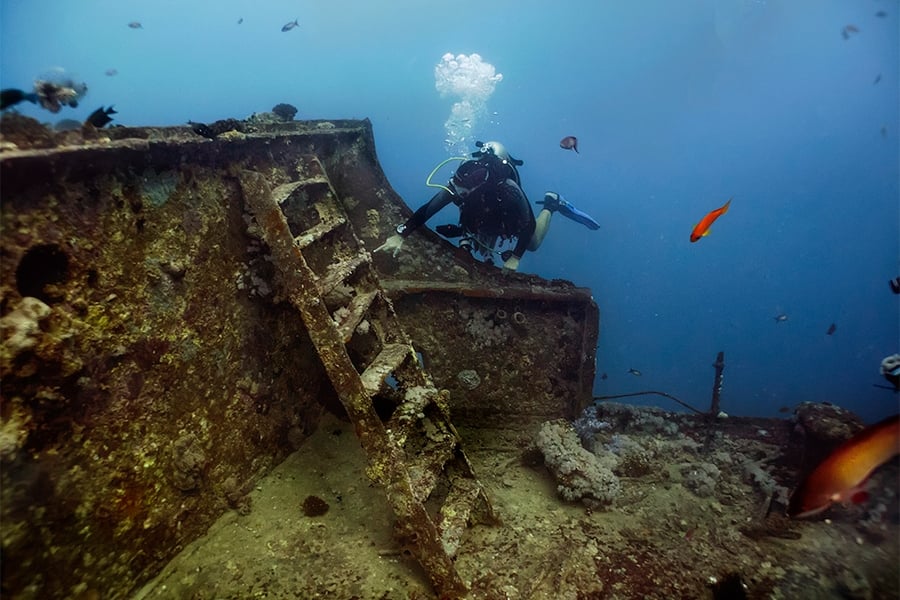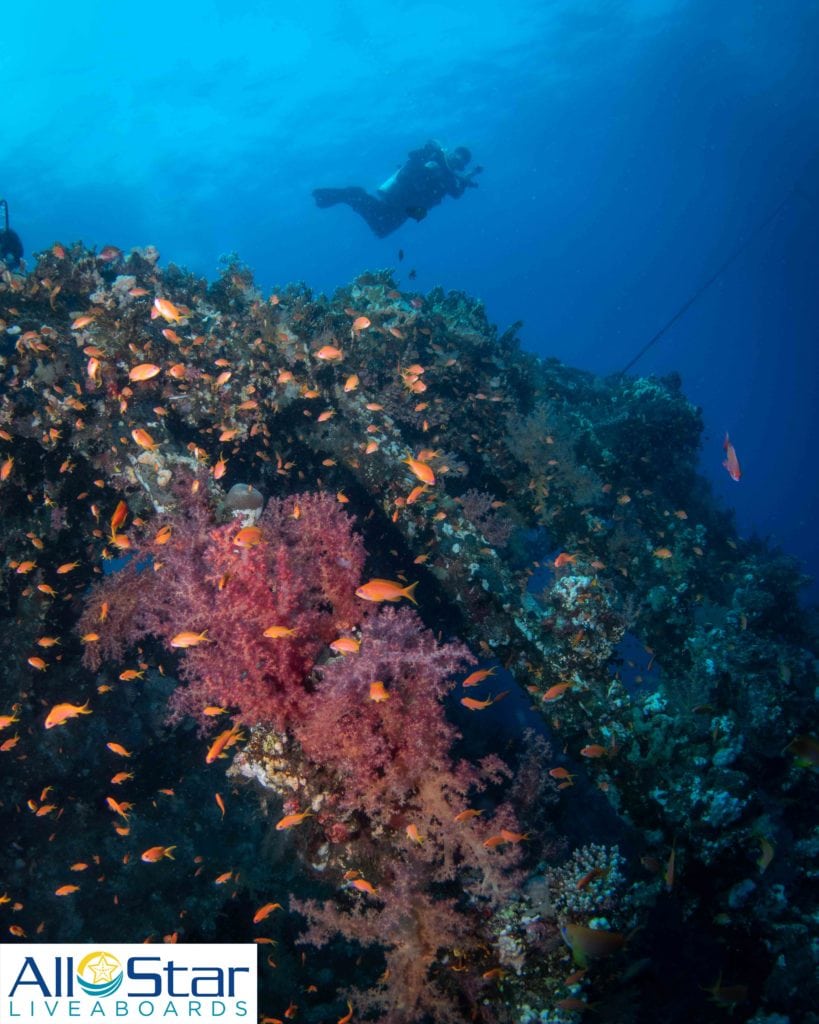Intro to Red Sea Wrecks
For those who love wreck diving, the Red Sea should be on your bucket list. For those who prefer reefs, the wrecks of the Red Sea should be on your bucket list, too. Many a ship has met its demise in the tropical waters, and over the years, the abundant coral and colorful fish have taken over and decorated these ships, making them dives that will satisfy any diver.

The All Star Scuba Scene in the Red Sea usually visits a few wrecks on every itinerary, but those wanting to see as many as possible should check out specific Wreck Week itineraries, or any of the North Red Sea trips. Here’s a few of the most commonly dived shipwrecks in the Northern Red Sea (or shall I say shipreefs as they have very much become a part of the reef).
SS Thistlegorm
Probably the most popular wreck diving in the Red Sea (and one of the most popular wreck dives in the world) is the SS Thistlegorm. It was a World War II British Supply Ship that went down in 1941 after departing Glasgow, England with Alexandria as its destination. But it had to take the long way around, heading south along the west side of Africa, around South Africa and then north, eventually to the Suez.
When she arrived to the Suez, two ships had collided and blocked the entrance to the canal, and she was waiting to proceed. On October 6, in the middle of the night, two Heinkel He-111 aircrafts had been on a search to destroy another ship, but they were returning without finding it. Spotting the Thistlegorm at anchor, they decided to drop two unused bombs, both of which struck the ship.
Jacques Cousteau was the first to locate the wreck in 1956 using knowledge from local fisherman, but it was not found and dived again until the early 1990s. Today, divers can find all sorts of historical relics.

Highlights include two LMS Stanier Class 8F steam locomotives destined for the Egyptian Railways that were blown off the deck and sit in the sand. Many trucks with motorbikes stacked in the truck beds. There are even still intact Wellington boots. But that’s not all. Schools of fish swarm the bow and colorful soft corals grow on the hull of the ship. Orange and pink anthias dart around the winch, and crocodile fish can be seen lounging on the deck.
The ship sits around 100ft in the sand, and the shallowest point is about 50ft. Night dives are possible and can be excellent if the current is slack.
The Wrecks of Abu Nuhas
Many ships have met their demise on Abu Nuhas Reef and often in very similar manners. Prior to arriving near this shallow coral head, Captains would likely be awake for many hours while navigating the narrow waters of the Suez Canal. Upon making a safe passage, they would probably head to bed, leaving their ships in the hands of the 2nd in command. Be it a misjudgment in the captain’s navigation orders or an officer getting off course, all three of these vessels ended up as shipwrecks.
Giannis D
The stern of this wreck is a very popular image of the Red Sea as it is very intact and sits at a 90 degree angle. The Giannis D was carrying timber when she struck the reef in 1983, and the ship sits between 20 and 90ft.

The stern section has some easy and fun swim throughs around the engine room and various crew quarters. Because of the angle, swimming through the sections feels very strange when exhaled bubbles hit the ceiling and seem to move sideways instead of up. The midsection is mostly broken up, and the bow has lots of coral growing on it. We saw several scorpionfish lounging on this wreck, and the shallower parts of the wreck are like a mini reef with coral and lots of fish.
Chrisoula K
This ship struck the reef in August 1981 and is known as the ‘Tile Wreck”. It was loaded with Italian floor tiles that are still easily seen today, some of which you can even make out the markings.

The wreck is between 40 and 90ft deep and rich with marine life. Lots of openings in the wreck allow you to swim through and see the stacks and stacks of tiles that are encrusted with colorful corals. Parrotfish, butterflyfish and angelfish are common.
Carnatic Wreck
When the Carnatic ran aground in 1869 on Abu Nuhas Reef, it was carrying £40,000 of unfinished coins destined for the Indian Mint. While you probably won’t find any lost treasure, you will find stunning reef life and a wreck draped in colorful soft coral and buzzing with fish life including millions of anthias. You can also find some old port wine bottles inside the ship, and dolphins occasionally cruise by.
Only the frame of the ship remains, and in big open sections, you can swim through, although you may the open areas crowded with sweeper fish by the thousand. As you move, the schools of juveniles move as one unit, looking like a curtain of glitter making space for you and then refilling the space behind you. On the remaining structural beams, huge pink and orange soft corals drape the wreck.

Kingston Wreck (Shag Rock)
Covered in coral and mostly disintegrated, parts of this wreck don’t even look like a wreck anymore, but rather a colorful reef teeming with fish. The propeller is still prominent and will remind you this reef is on a ship.

Built in 1871 and sunk in 1881, the ship was carrying coal and ran aground on Shag Rock. With the deepest point around 55ft and shallowest around 20ft, the wreck makes for a great shallow dive allowing for plenty of bottom time to explore.
Yolanda Reef (Ras Mohamed National Park)
Let the jokes begin. The Yolanda (Jolanda) was carrying toilets and bathtubs when she struck the Ras Mohamed reef in 1980. While the wreck itself has actually fallen over the reef into deep water, it left behind much of its cargo on a shallow reef (now called the Yolanda Reef).
You can see piles of toilets between 30-90ft, a few of which have been positioned for a particular photo opportunity. There are also stacked bathtubs that now look mostly like big rectangular boxes. The toilets and bathtubs are quite overgrown with soft corals, and the surrounding area is rich with colorful marine life.

The Barge (Gubal Island)
Not much is known about the origins of the remains of a wreck simply called “The Barge,” but it has attracted tons of marine life (and is surrounded by healthy reef), so this is a favorite dive both during the day and at night! Massive moray eels and nudibranchs of all colors are common sights here. The area surrounding the wreck is a healthy reef with many species of fish and corals.
These are just a few of the many wrecks that can be found in the Red Sea. For more information on our trips and the All Star Scuba Scene, send us an email or give us a call.


